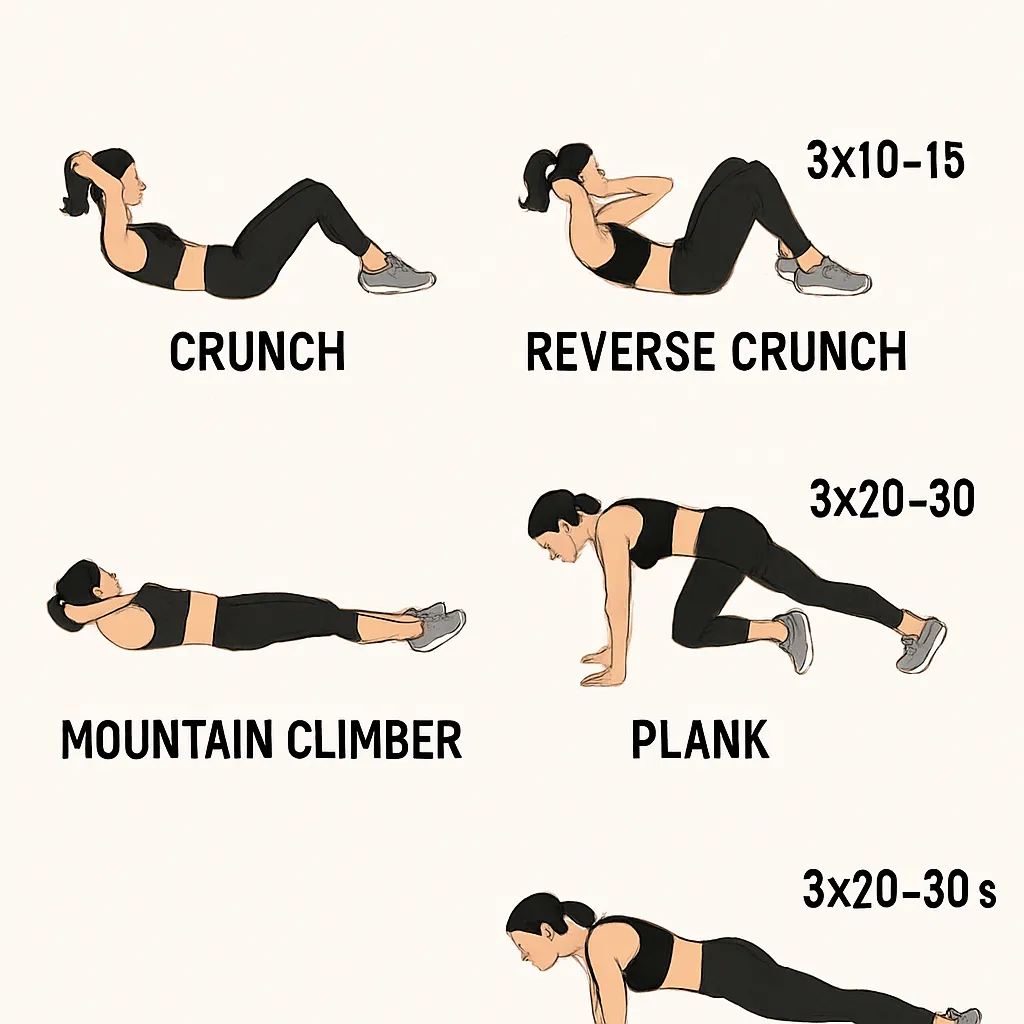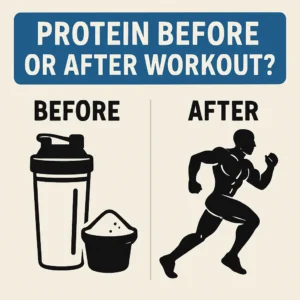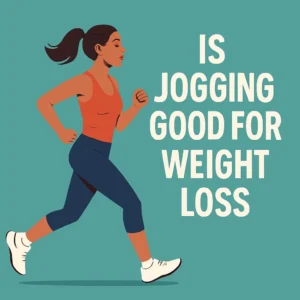Are you looking to sculpt strong, defined abs without stepping foot in a gym or purchasing pricey machines? In this comprehensive guide, we’ll dive into the best abs workout at home without equipment, answering your core question of how to achieve impressive results using just your bodyweight. Whether you’re a beginner seeking foundational moves or an experienced fitness enthusiast craving new challenges, these exercises and program tips will help you build a solid core, boost stability, and improve posture—all from the comfort of your living room.
Why Choose No-Equipment Ab Workouts?
Equipment-free training offers a range of benefits beyond just cost savings. By relying on your own body, you can focus on mastering perfect form, engage deeper stabilizer muscles, and reduce the risk of injury compared to heavy-weight movements. Bodyweight ab exercises also allow for greater flexibility in programming, enabling you to mix and match variations for continuous progress.
Moreover, no-equipment workouts are highly accessible: you can perform them anywhere—be it your bedroom floor, a park bench, or even a hotel room when traveling. This convenience ensures consistency, which is key for visible results. You’ll never miss a session due to lack of gear or gym closures, making it easier to stick to a routine long-term.
Finally, equipment-free training often emphasizes functional movement. Strengthening your core without machines translates directly to everyday activities—lifting groceries, carrying kids, or simply maintaining good posture while seated at a desk. Let’s explore the specific advantages in more detail below.
Benefits of Equipment-Free Training
First, you save money and space—no need for bulky ab machines or weight benches. Instead, you can dedicate that budget to other health essentials like quality nutrition or recovery tools.
Second, bodyweight workouts inherently improve balance and proprioception, since your core must stabilize your spine without external support. This leads to better overall athleticism and injury prevention.
Third, equipment-free exercises tend to be lower impact on the spine and joints, provided you maintain proper form. This makes them suitable for individuals of all fitness levels, including those rehabbing from minor back issues.
Fourth, the variety of movements—from crunches to planks—targets every layer of the abdominal wall, ensuring comprehensive core development over time. You’ll activate the rectus abdominis, obliques, transverse abdominis, and even hip flexors in different ways.
Lastly, the mental challenge of bodyweight workouts fosters discipline and creativity; you’ll learn to innovate with tempo changes, holds, and rep schemes instead of relying on increasing weight plates.
Now that we’ve covered why no-equipment ab workouts rock, let’s dive into the top moves you can start today.
Accessibility and Convenience
One of the most appealing aspects of equipment-free ab routines is the absolute freedom they afford. With just floor space, you can train at dawn before anyone else in the household wakes up, or catch a quick session during your lunch break.
Also, the absence of gear means zero setup time—you simply roll out a yoga mat or towel and get going. This convenience encourages consistency, which is the single most important factor in developing visible abs.
Travelers especially benefit from these workouts: whether you’re in a hotel room with no gym, at a friend’s house, or even camping, you can always maintain your core routine without compromise.
Moreover, group fitness sessions in small apartments or living rooms can be conducted without noise or equipment concerns. Everyone can follow along, making these workouts ideal for virtual classes or social media challenges.
Ultimately, equipment-free ab training removes excuses and barriers, empowering you to build a resilient core wherever life takes you.
Top 10 Ab Exercises Without Equipment
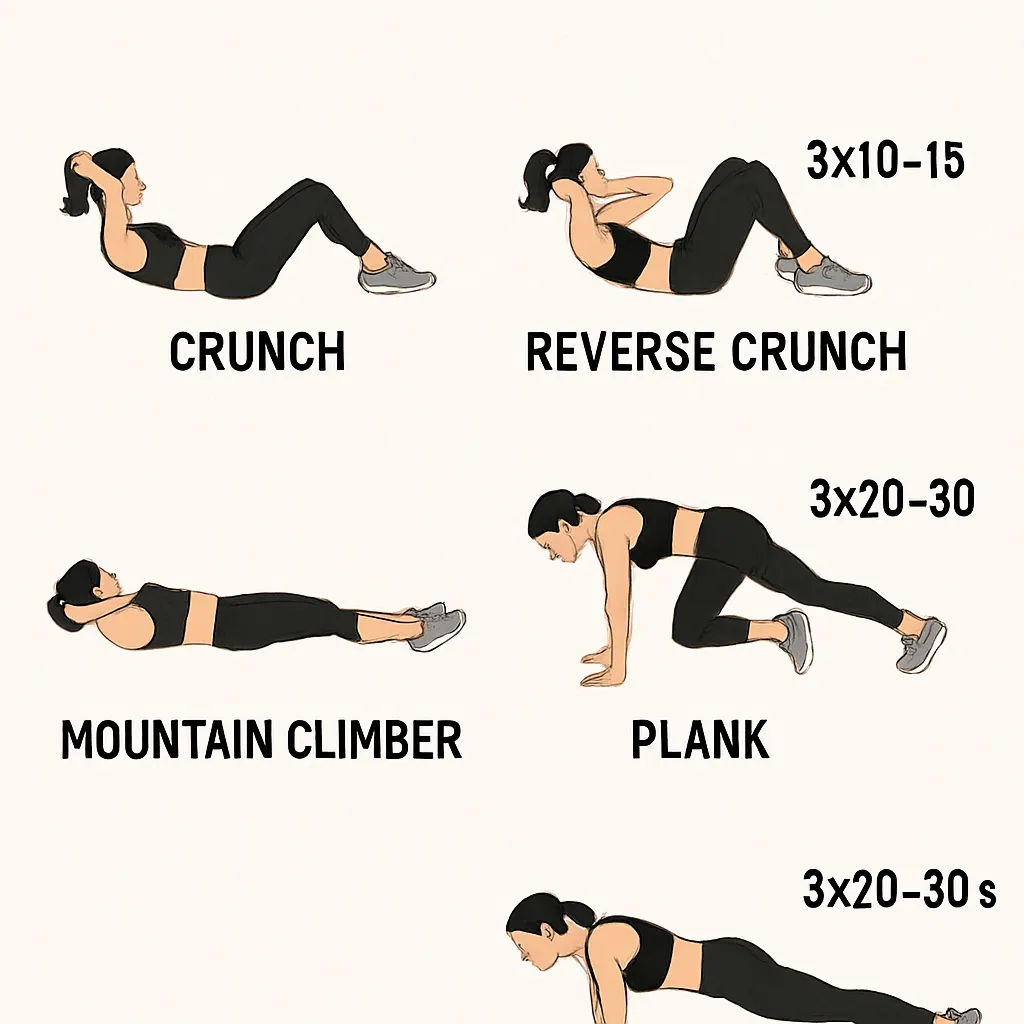
Below are the ten best core-building exercises you can perform at home with zero equipment. Each movement focuses on a specific region of your abdominals or core stabilizers, helping you craft a balanced, well-defined midsection.
Crunch Variations
Crunches are the classic ab exercise and a staple in any bodyweight routine. Start lying on your back, knees bent, feet flat on the floor. Place hands lightly behind your head, elbows wide.
Lift your shoulder blades off the ground by contracting your abs, exhaling at the top of the movement. Avoid pulling on your neck—focus on initiating the lift from your core.
For variety, try:
- Traditional Crunch: Elbows wide, lift shoulder blades.
- Reverse Crunch: Lift hips off the ground by curling your pelvis toward your ribcage.
- Vertical Leg Crunch: Extend legs toward the ceiling and crunch up, keeping legs straight.
- Oblique Crunch: Bring right elbow to left knee and vice versa.
Perform 3–4 sets of 12–20 reps, adjusting reps based on your strength level and tempo.
Remember to keep your lower back pressed into the floor to engage the transverse abdominis and avoid strain.
These variations ensure you target both the upper and lower regions of your rectus abdominis effectively.
Plank Series
Planks are an isometric exercise that builds incredible core stability and engages deep spinal stabilizers. Begin in a forearm plank position—elbows under shoulders, body in a straight line from head to heels.
Hold this position, keeping hips level and abs braced. Avoid sagging in the lower back or piking your hips too high.
Plank variations include:
- Forearm Plank: Standard hold for time.
- High Plank: Hands on the floor, arms straight.
- Side Plank: Stack feet and lift hips, supporting on one forearm.
- Plank with Shoulder Taps: In a high plank, tap each shoulder with the opposite hand while maintaining hip position.
Aim for 3–5 sets of 30–60 seconds for each variation. Increase duration as you get stronger.
Planks also train your glutes, shoulders, and even your legs to hold a stable position—making them a full-body movement.
Practicing planks daily will dramatically improve your posture and reduce back pain by reinforcing spinal support muscles.
Mountain Climbers
Mountain climbers combine core activation with cardio, raising your heart rate while challenging your abs and hip flexors. Start in a high plank position, then drive one knee toward your chest, alternating legs quickly.
Maintain a flat back and tight core throughout the movement to avoid excessive lumbar extension. Imagine pulling your belly button toward your spine with each rep.
This dynamic exercise also recruits your shoulders, triceps, and quads, making it an efficient full-body burn. Incorporate them into HIIT circuits for an added metabolic boost.
Begin with 3 sets of 30 seconds of continuous movement, resting 30 seconds between sets.
As you progress, increase speed or extend the duration to challenge your endurance.
Mountain climbers are perfect for days when you want to combine core work with cardiovascular conditioning in one movement.
Bicycle Crunches
Bicycle crunches are a highly effective move for targeting the rectus abdominis and obliques simultaneously. Lie on your back, hands behind your head, and lift your shoulders and legs off the ground.
Extend your right leg while bringing your left knee toward your chest, twisting your torso so your right elbow reaches toward the left knee. Alternate sides in a pedaling motion.
Keep the movement controlled—slow down at the end range to maximize time under tension.
Perform 3 sets of 15–20 reps per side, focusing on quality over speed.
This exercise also improves hip flexor strength and coordination, translating well to athletic activities like running or cycling.
Pay attention to keeping your lower back pressed into the mat and avoid jerking your neck forward.
Leg Raises
Leg raises focus on the lower abs and hip flexors. Lie flat on your back with legs extended. Place your hands under your glutes for support.
Keeping legs straight, lift them toward the ceiling until hips slightly lift off the floor. Slowly lower them back down without touching the ground.
Perform 3–4 sets of 10–15 reps. Control the descent to engage muscles throughout the range of motion.
For added difficulty, pause for 1–2 seconds with legs hovering a few inches above the floor.
This move also recruits the lower back stabilizers, promoting overall spinal health when done correctly.
Begin with bent knees if straight-leg raises are too challenging, then progress over time.
Heel Taps
Heel taps target the obliques and outer ab muscles. Lie on your back with knees bent at 90 degrees, feet off the floor. Reach your hands toward your heels, alternating taps side to side like a windshield wiper.
Keep your shoulders lifted and core engaged throughout the movement. Move slowly to maximize muscle recruitment.
Complete 3 sets of 20–30 taps, resting briefly between sets.
This exercise also improves lateral stability and hip mobility when performed with proper control.
To intensify, hold a small weight or water bottle in your hands while tapping.
Focus on smooth, controlled taps rather than speed to avoid momentum.
Russian Twists
Russian twists work the obliques and transverse abdominis. Sit with knees bent and feet flat. Lean back slightly and lift your feet off the ground, balancing on your sit bones.
Clasp your hands or hold a weight, then rotate your torso left and right, tapping the floor beside your hips each rep. Keep your core braced to avoid rounding your lower back.
Perform 3 sets of 20 twists (10 per side).
For beginners, keep feet on the floor until you build enough balance to lift them.
This move enhances rotational strength and control, essential for sports like golf and tennis.
Maintain a controlled tempo—avoid swinging your arms to generate momentum.
Flutter Kicks
Flutter kicks engage the lower abs, hip flexors, and quads. Lie on your back with legs extended, hands under your glutes. Lift legs a few inches off the floor and kick them alternately in a quick, fluttering motion.
Keep your lower back pressed into the mat and your core braced. Avoid arching your spine.
Perform 3 sets of 30–45 seconds of continuous fluttering.
This exercise also improves lower body endurance and coordination, making it a great finisher for any ab session.
To reduce neck strain, keep your head resting on the floor or supported by your hands.
Focus on small, rapid kicks rather than large swings to maximize muscular engagement.
Hollow Body Holds
Hollow body holds are a gymnastic staple for core strength and stability. Lie on your back and lift your shoulders and legs off the ground, forming a shallow “banana” shape with your body. Arms extend overhead beside your ears.
Press your lower back into the floor and hold this position, keeping your core fully engaged. Avoid letting your back arch.
Hold for 20–40 seconds per set, completing 3–4 sets.
This move targets the entire core musculature, including the deep transverse abdominis and lower back stabilizers.
Progress by increasing hold time or by adding flutter kicks while in the hollow position.
Mastering the hollow hold will significantly improve your body control and posture.
Side Planks
Side planks focus on the obliques and lateral stabilizers. Lie on your side with legs stacked and elbow directly under your shoulder. Lift hips to form a straight line from head to heels.
Hold this position for 30–60 seconds, then switch sides. Perform 3 sets on each side.
Maintain a neutral spine and engage your glutes to prevent hip sagging.
For an extra challenge, lift the top leg or perform hip dips—lower your hips toward the floor and lift back up.
This exercise enhances lateral core strength, essential for running, jumping, and changing directions.
Consistent practice of side planks will improve your balance and reduce lower back discomfort.
How to Structure Your Ab Workout Routine
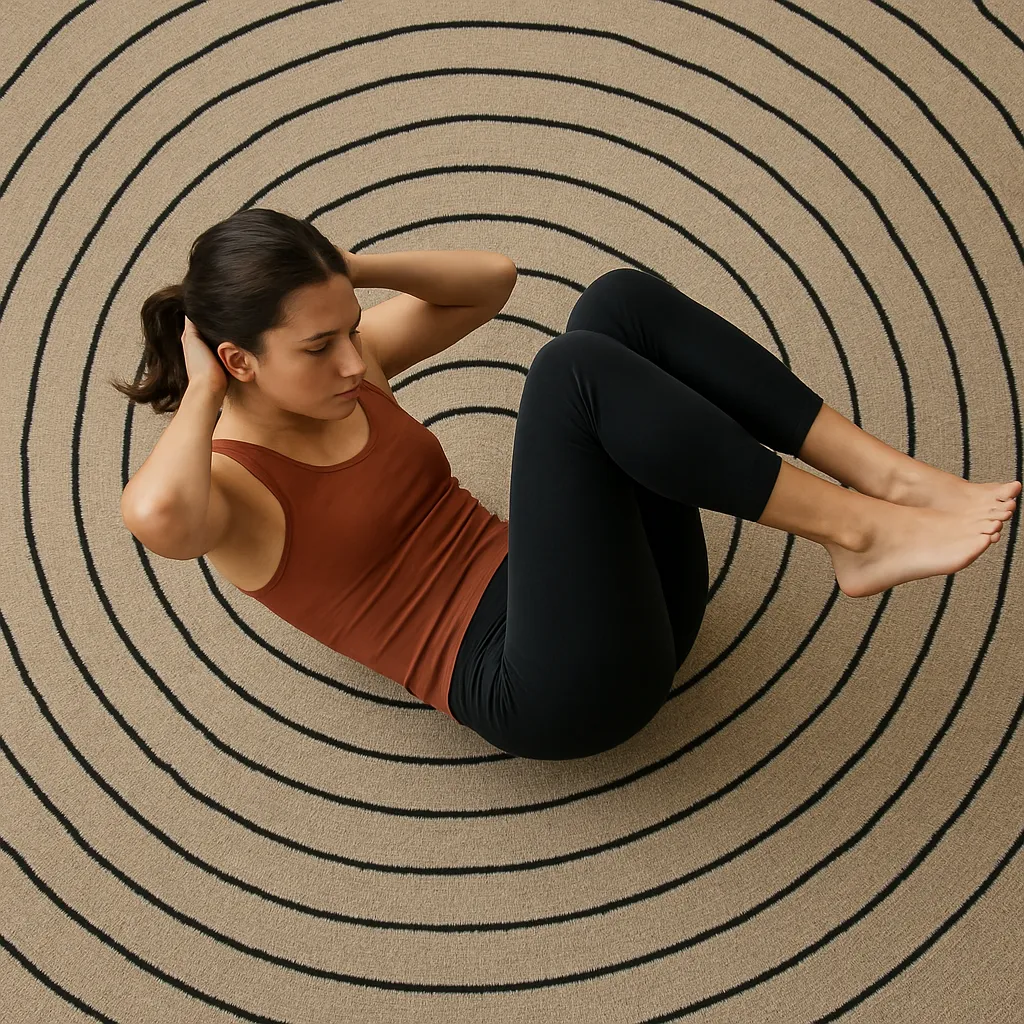
Designing an effective ab workout routine involves balancing exercise selection, frequency, and progression. Start by choosing 4–6 exercises from the list above, ensuring you target different regions of your core. A typical session might include one crunch variation, one plank variation, and two dynamic exercises like mountain climbers and flutter kicks.
Next, decide on sets and reps. Beginners can aim for 2–3 sets of 10–15 reps per exercise, while intermediate trainees might perform 3–4 sets of 15–25 reps or timed holds of 30–60 seconds for isometric moves.
Include rest periods of 30–60 seconds between sets to maintain workout intensity. As you progress, shorten rest intervals or add more challenging variations to continue building strength.
Here’s a sample routine structure to follow:
| Exercise | Type | Sets | Reps/Time |
|---|---|---|---|
| Crunch Variations | Dynamic | 3 | 15–20 reps |
| Forearm Plank | Isometric | 3 | 45–60 sec |
| Mountain Climbers | Dynamic | 3 | 30 sec |
| Leg Raises | Dynamic | 3 | 12–15 reps |
| Side Plank | Isometric | 3 per side | 30–45 sec |
By rotating exercises weekly and gradually increasing volume or intensity, you’ll avoid plateaus and keep your core engaged.
Don’t forget to include a proper warm-up (e.g., light cardio and dynamic stretches) and cool-down (static stretches targeting the abs and hip flexors) in each session.
Tracking your workouts—through a fitness journal or app—helps ensure progressive overload, which is the key to continuous improvement.
Frequency and Duration
For most individuals, performing ab workouts 3–4 times per week is sufficient to see tangible results. This frequency allows adequate recovery for the muscles while maintaining consistent stimulus.
Each session can last between 15 to 30 minutes, depending on how many exercises and sets you include. Shorter, more frequent sessions can be just as effective as longer workouts, provided you maintain intensity.
Beginners should start at the lower end—around 15 minutes per session—focusing on mastering form. Intermediate and advanced trainees can extend sessions up to 30 minutes, incorporating additional sets, holds, or supersets.
Allow at least one full rest day between intense core sessions to let muscle fibers repair and grow stronger. Active recovery—like light yoga or walking—can help alleviate soreness without compromising progress.
Always listen to your body. If you experience sharp pain (not to be confused with normal muscle fatigue), reduce volume or take extra rest days to prevent injury.
Adhering to a consistent frequency and duration will ensure steady progression toward defined, powerful abs.
Tips for Maximum Results
1. Focus on Mind–Muscle Connection: Actively think about engaging your abs with each rep. Visualizing the muscles contracting can amplify recruitment and results over time.
2. Control the Tempo: Slowing down eccentric (lowering) phases increases time under tension, which promotes muscle growth. Try a 3-second eccentric count on crunches and leg raises.
3. Breathe Correctly: Exhale during the exertion phase (e.g., crunch up, twist) and inhale during the release. Proper breathing supports core stabilization and prevents unnecessary strain.
4. Vary Your Routine: Prevent plateaus by rotating exercises, rep schemes, and workout order every 4–6 weeks. Incorporate advanced variations like weighted Russian twists or plyometric plank jacks when ready.
5. Prioritize Nutrition: No matter how strong your core, visible abs require a low enough body fat percentage. Combine workouts with a balanced diet rich in lean proteins, healthy fats, and complex carbohydrates for optimal results.
6. Stay Consistent: Visible changes take time. Commit to your program for at least 8–12 weeks before expecting noticeable definition. Keep track of your progress with photos and measurements.
Common Mistakes to Avoid
Even the best-designed workouts fail without proper execution. Many people unintentionally sabotage their progress by performing exercises incorrectly or overlooking critical recovery factors. Understanding and correcting these common mistakes will help you make the most of your no-equipment ab routine.
Understanding Proper Form
One of the biggest errors is using momentum instead of muscle power. Swinging your body or jerking your neck during crunches reduces the workload on your abs and shifts stress to other areas, increasing the risk of injury.
A second mistake is allowing the lower back to arch during leg raises or planks. This posture puts undue pressure on spinal discs and diminishes core engagement. Always press your lower back into the floor or maintain a straight line from head to heels.
Third, many lifters forget to brace properly. Think about tightening your midsection as if preparing for a punch in the stomach. This action recruits deeper muscles like the transverse abdominis, improving spine support.
Fourth, beginners often neglect breathing technique. Holding your breath increases intra-abdominal pressure and can lead to dizziness. Practice synchronized breathing to support each movement.
Finally, rushing through reps to finish faster leads to poor quality. Slower, controlled movements maximize muscle tension and deliver better results over time.
By mastering proper form early, you’ll build a safer, more effective foundation for future progress.
Balancing Core Strength
A well-rounded core involves more than just abs; it includes obliques, lower back, and hip flexors. Neglecting any of these areas can create imbalances that may lead to poor posture or injury.
To balance your training, combine anterior exercises (crunches, leg raises) with posterior chain movements (supermans, glute bridges) performed bodyweight-style.
Also, include rotational moves like Russian twists to develop oblique strength and stability. This holistic approach ensures your spine is supported from all angles.
Avoid overtraining one region; if you feel persistent soreness in the lower back or hip flexors, reduce volume and focus on recovery techniques like foam rolling and gentle stretching.
Remember, a balanced core enhances athletic performance in every sport and daily activity. Prioritize comprehensive development rather than chasing vanity muscles alone.
With balanced strength, your entire midsection will function optimally, supporting healthy movement patterns and reducing injury risk.
Frequently Asked Questions

How often should I do ab workouts?
Ideally, you should train abs 3–4 times per week, allowing at least one rest day between intense sessions. Your frequency may vary based on workout intensity and recovery ability. Beginners can start with two sessions weekly, while advanced trainees might increase to four sessions, monitoring for signs of overtraining like persistent soreness or fatigue.
Can I get abs without equipment?
Absolutely! With consistent bodyweight training, proper form, and nutrition, you can develop a strong, defined core without any machines. Equipment-free exercises engage all layers of your abdominal wall and stabilizer muscles, and when paired with a calorie-controlled diet and cardiovascular activity, they will reveal the abs you’ve worked so hard to build.
